There are over 30 different types of spiders in West Virginia. These arachnids are among the most misunderstood arthropods in North America, which is why many people fear them.
Spiders aren’t as scary as they seem. Although it isn’t always obvious, these critters are often as scared of you as you are of them. That’s why they run when you get close.
Spiders rarely bite people, despite what popular culture would have you believe. Even spiders that bite often can’t harm you. Most bites are painless.
Those that show symptoms might cause mild skin reactions in the bite area, but no more than an ant or wasp’s sting. Of all the spiders in West Virginia, only one species is of medical concern.
In this guide, you’ll learn about the different spider species that call West Virginia home. You’ll learn interesting facts about each one, how to identify them, and which species to steer clear of.
Table of Contents
Spiders in West Virginia
1. Southern Black Widow
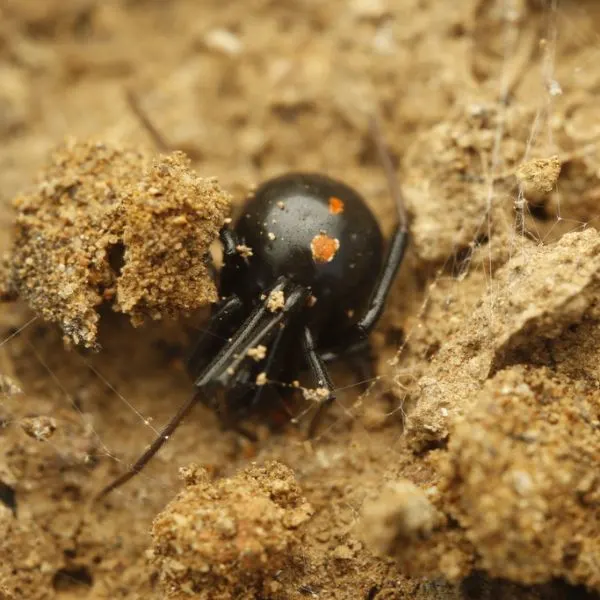
- Experience Level: Advanced
- Family: Theridiidae
- Scientific Name: Latrodectus mactans
- Other Names: Hourglass Spider, Widow Spider, Eastern Black Widow
- Adult Size: Up to 0.5 inch
- Lifespan: 1 to 3 years
- Average Price Range: N/A
The southern black widow is West Virginia’s only highly venomous spider. Its venom is said to be up to 15 times more potent than a rattlesnake’s and can trigger medically significant symptoms in humans. Fortunately, deaths from widow bites are rare.
Southern black widows produce a neurotoxic venom that may trigger latrodectism in humans. Symptoms of latrodectism include pain, nausea, vomiting, difficulty breathing, fever, and profuse sweating.
If you suspect a black widow has bitten you, seek urgent medical attention in the nearest hospital. You’ll likely receive antivenom to prevent the spider’s venom from causing complications, especially if you have a weak immune system.
Despite this species’ notoriety for being highly venomous, it’s a pretty timid creature that rarely bites people. It runs when threatened instead of attacking, and bites are often the result of accidental forced skin contact where the spider cannot escape.
Southern black widows get the “widow” in their name from the tendency of females to consume their male partners after mating. Female southern black widows are much larger than males, and they live much longer.
You can identify southern black widows by the reddish hourglass marking on the underside of their bulbous bellies. Their bodies are glossy black, and they have comb-like structures on their legs that help in maintaining their webs.
These spiders spin sticky cobwebs with tangled silk, which they use to catch prey. These critters wait for insects or other arthropods to wander into the cobwebs and get stuck, then they rush in to immobilize their victims with venom before eating them.
2. Triangulate Cobweb Spider
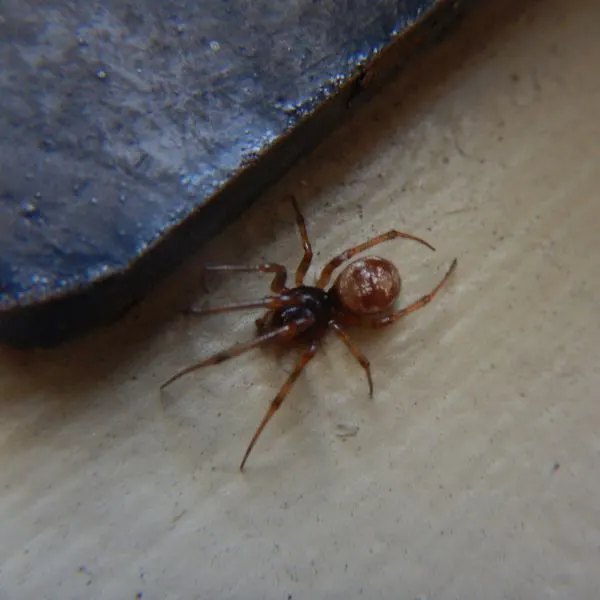
- Experience Level: Beginner
- Family: Theridiidae
- Scientific Name: Steatoda triangulosa
- Other Names: Checkered Cobweb Spider, Triangulate Comb-footed Spider, Triangulate Bug Spider, Triangulate Household Spider
- Adult Size: Up to 0.25 inches
- Lifespan: 1 to 3 years
- Average Price Range: N/A
The triangulate cobweb spider belongs to the same family as the southern black widow. Its abdomen is bulbous and larger than its cephalothorax, and its legs have comb-like structures toward the end.
Unlike black widows, this arachnid is brown. Its belly has several wavy dark brown lines running down it. The spaces between these wavy lines resemble triangles, hence the triangulate in the spider’s name. These spaces are light and stippled with white spots.
Triangulate cobweb spiders build messy silk cobwebs with sticky strands to catch prey. These critters feed on various small insects and arthropods, including other spiders. Like widows, these arachnids wait for prey to get stuck in their webs before attacking.
Despite being related to black widows, triangulate cobweb spiders are harmless arachnids. Their venom is nowhere near as toxic as that of black widows, and the spiders rarely bite people except when threatened and unable to escape.
You’ll find triangulate spiders in various places. These arachnids often inhabit dark corners inside your house, garages, cellars, and attics.
3. Bold Jumping Spider
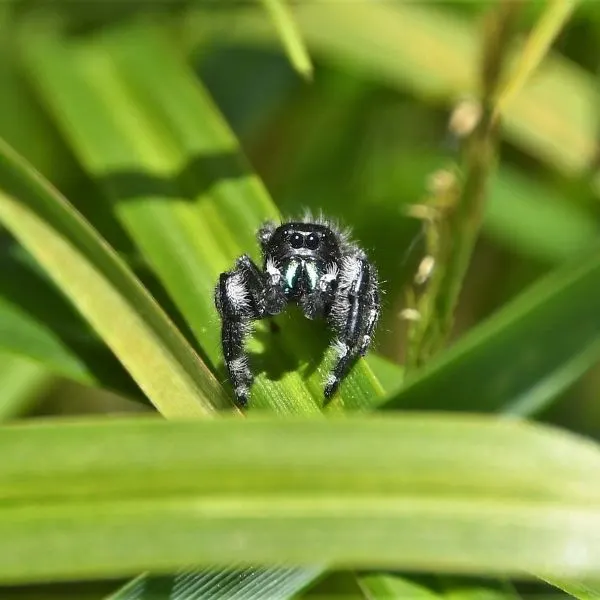
- Experience Level: Beginner
- Family: Salticidae
- Scientific Name: Phidippus audax
- Other Names: Bold Jumping Spider, Bold Jumper, Three-spotted Jumping Spider, White-spotted Jumper, White-spotted Jumping Spider
- Adult Size: 0.25 to 0.75 inch
- Lifespan: 1 year
- Average Price Range: N/A
The bold jumping spider is a hairy black arachnid with stout, noticeably short legs and three reddish spots on the second half of its abdomen. It has flecks of white hair on its legs, and its fangs have a metallic green hue.
This arachnid belongs to a family of spiders that can jump several times their body lengths. Like its relatives, this spider jumps by altering the pressure in its legs and using silk draglines to regulate its movements while jumping.
The “bold” in this spider’s name comes from its tendency to make risky high jumps. Fortunately, the dragline it spins every time it jumps helps reduce the risk of injury in case a jump fails.
Bold jumping spiders don’t spin web traps like other spiders in West Virginia. Instead, these arachnids hunt down their targets. They have excellent vision, which they use to scout their targets before ambushing them.
Bold jumping spiders are common outdoors, where they often stay on vertical surfaces. When inactive, these spiders hide in small silk nests, which they tend to build among vegetation.
4. Yellow Garden Spider
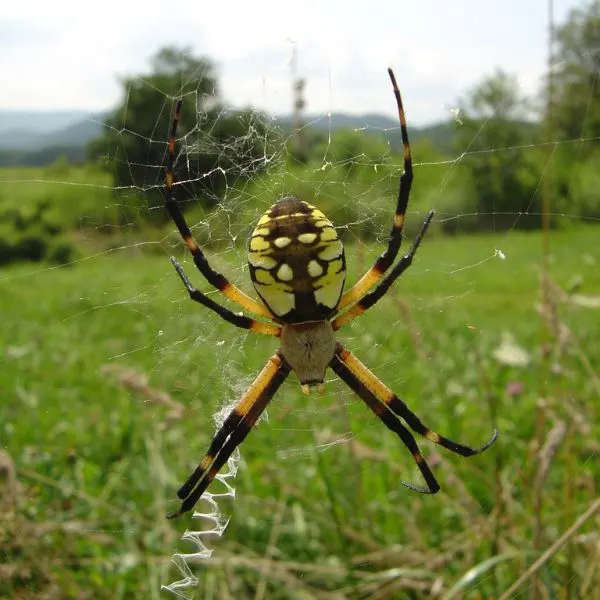
- Experience Level: Beginner
- Family: Araneidae
- Scientific Name: Argiope aurantia
- Other Names: Black and Yellow Garden Spider, Steeler Spider, Black and Yellow Argiope, Zipper Spider, Golden Garden Spider, McKinley Spider, Corn Spider, Zigzag Spider
- Adult Size: 0.75 to 1.1 inches
- Lifespan: 1 year
- Average Price Range: N/A
The yellow garden spider is an orb-weaver with a stunning black and yellow body pattern. Its carapace is covered in whitish hair, while its mostly yellow abdomen has a broad black stripe in the center with two pairs of yellow spots.
This arachnid is called an orb-weaver because it likes to build large, spherical webs that are shaped like orbs. These webs have a wheel-like structure with radial and circular threads that spread out from the center.
Yellow garden spiders often hang upside-down in the center of these webs while waiting for flying insects to hit the strands and get stuck. When this happens, the spiders rush to inject their victims with venom and eat them.
Yellow garden spiders are harmless arachnids that don’t bite people unless provoked. Even when forced to bite, the venom they inject is too mild to cause medically significant symptoms.
You’ll typically find these spiders in gardens or among vegetation in woodlands and tallgrass prairies, where they play beneficial environmental roles by keeping the populations of insects and other arthropods in check.
5. Marbled Orbweaver

- Experience Level: Beginner
- Family: Araneidae
- Scientific Name: Araneus marmoreus
- Other Names: Pumpkin Spider
- Adult Size: 0.2 to 0.7 inch
- Lifespan: 1 to 2 years
- Average Price Range: N/A
The marbled orb-weaver is a fascinating arachnid with an orange body and a large round abdomen. This abdomen is variable in color and may be yellow, orange, brown, or greenish.
The spider’s name comes from the marble-like pattern on its abdomen. This pattern is often symmetrical and is caused by a network of typically brown, black, or orange lines running across the abdomen.
You’ll find most marbled orb-weavers among vegetation in forests and woodlands, where they spin large orb webs. These spiders don’t sit in the center of their webs. Instead, they hide in small retreats on the edges of their webs.
Adults build these retreats out of silk and dried leaves, while juveniles build theirs using only silk. While in the retreat, these spiders maintain a connection to the center of their webs via a single line of silk or “signal thread.”
This signal thread vibrates to alert the spiders whenever prey or other intruders disturb their webs. These spiders then rush out to investigate. If the vibration is caused by trapped prey, they immobilize their catch with venom and wrap it to eat later.
Marbled orb-weavers are harmless creatures that run when threatened instead of defending themselves. Besides being timid, the venom of these arachnids is not medically significant, so there’s no need to fear them.
6. Northern Yellow Sac Spider
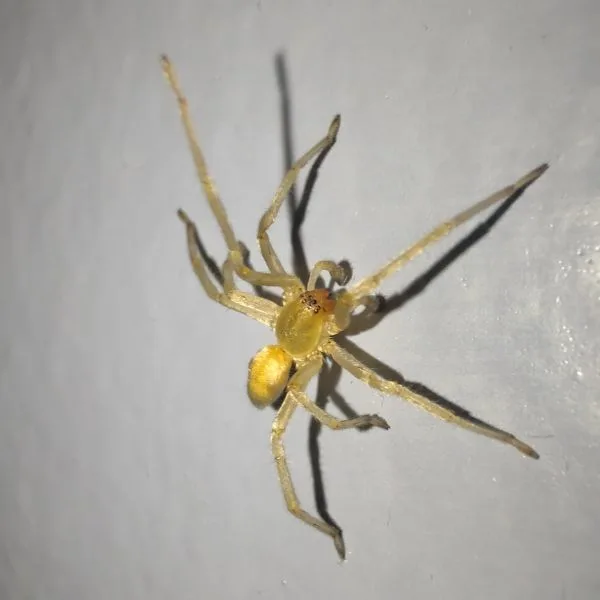
- Experience Level: Beginner
- Family: Eutichuridae
- Scientific Name: Cheiracanthium mildei
- Other Names: Long-legged Sac Spider, American Yellow Sac Spider
- Adult Size: 0.16 to 0.4 inches
- Lifespan: 1 year
- Average Price Range: N/A
The northern yellow sac spider is a greenish-yellow arachnid, but you may encounter variants with brownish or near-white pale bodies. This arachnid also has a darkened face and a short dark central stripe at the top of its abdomen.
Northern yellow sac spiders are common indoors, where they hide in crevices, closets, and other dark undisturbed parts of the house. These arachnids are nocturnal, so you might not notice them unless you’re awake at night.
Unlike most spiders in West Virginia, northern yellow sac spiders don’t spin webs for shelter or to catch prey. Instead, these critters build small silk sacs to rest in when inactive. That’s why they are called sac spiders.
Since these critters don’t rely on web traps to catch prey, they tend to hunt down their targets. They seize and inject their victims with venom before settling down to eat them. These spiders feed on insects and other spiders.
There are conflicting reports about these spiders’ readiness to bite people unprovoked, but the venom they produce is not medically significant. You might experience mild pain around the bite area, but symptoms scarcely exceed this.
7. Dark Fishing Spider

- Experience Level: Beginner
- Family: Pisauridae
- Scientific Name: Dolomedes tenebrosus
- Other Names: Giant Fishing Spider, Raft Spider, Dock Spider, Wharf Spider
- Adult Size: 0.27 to 1 inch
- Lifespan: 1 year
- Average Price Range: N/A
The dark fishing spider is a dark brown or grayish arachnid with a wide carapace and a series of W-shaped patterns on the second half of the abdomen. Its long legs have alternating brown and black or grayish bands and are often stretched out.
This spider is common among wooded vegetation in coastal areas, but it sometimes wanders into drier areas. If you live near damp woodlands, you may encounter this spider around your home.
While its appearance and size can make it seem dangerous, this critter isn’t. Like most spiders in West Virginia, the dark fishing spider doesn’t bite people except as a last resort when threatened.
Even when provoked to bite, the venom this spider injects is not medically significant. You might experience pain and redness or swelling around the bite area, but these symptoms quickly fade on their own.
Dark fishing spiders are skilled hunters that don’t build webs to trap prey. Instead, these arachnids hunt down their targets and immobilize them with venom after capturing them.
Although dark fishing spiders don’t spin silk webs, they use silk for other purposes. For example, female dark fishing spiders spin protective silk sacs to hold their eggs after laying them.
8. Striped Lynx Spider

- Experience Level: Beginner
- Family: Oxyopidae
- Scientific Name: Oxyopes salticus
- Other Names: Lynx Spider
- Adult Size: 0.16 to 0.3 inch
- Lifespan: 1 year
- Average Price Range: N/A
The striped lynx spider is a small whitish spider with dark bands running down its back and undersides. The face bears two thin black lines, and the undersides of its spiny legs also bear black lines.
Like other members of its family, the striped lynx spider is common among vegetation. This arachnid is a generalist predator that feeds on a wide variety of arthropods, including beneficial and pest insects.
This spider doesn’t use webs to catch prey, preferring to hunt down its targets. It gets the lynx in its name from its tendency to stalk its victims before pouncing on them like lynx cats.
Striped lynx spiders are similar to jumping spiders in their habit of jumping from place to place when active. Like jumping spiders, lynx spiders also spin silk lines when jumping to regulate their movements.
These arachnids are not aggressive toward people and won’t bite unless provoked. Even then, the venom these critters produce is too mild to trigger any medically significant symptoms in humans.
9. Six-spotted Fishing Spider
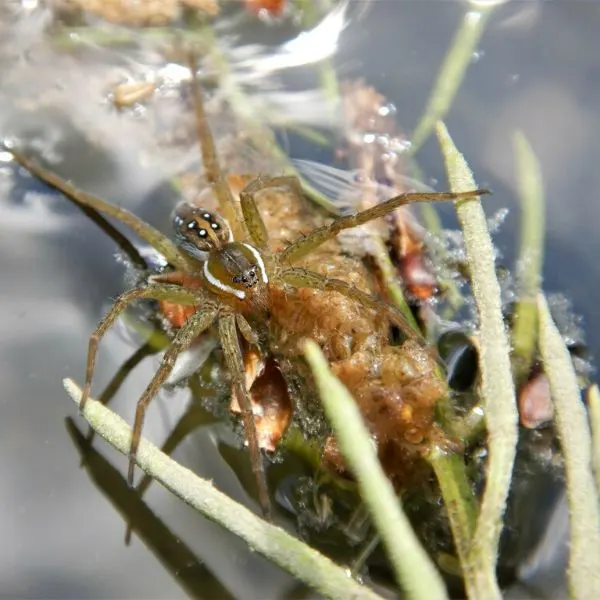
- Experience Level: Beginner
- Family: Pisauridae
- Scientific Name: Dolomedes triton
- Other Names: Dock Spider, Raft Spider
- Adult Size: 0.5 to 0.75 inch
- Lifespan: 1 year
- Average Price Range: N/A
The six-spotted fishing spider is a brown or gray spider with a white or pale yellow stripe running down either side of its cephalothorax and abdomen. It has several pairs of white spots on its abdomen, but these aren’t the spots after which it is named.
This spider’s name comes from the six spots present on its sternum (i.e. the underside of its cephalothorax). These spots help in differentiating it from other fishing spider species, such as the striped fishing spider.
You’ll find six-spotted fishing spiders around water bodies and riverside vegetation. These arachnids are semi-aquatic hunters that don’t use webs to catch prey. Fortunately for them, they are comfortable hunting on both land and water.
When hunting in water, six-spotted fishing spiders stand on the water’s surface and listen for ripples and surface vibrations that indicate there’s prey movement underneath. They use these signals to locate their targets before diving in to subdue them.
Six-spotted fishing spiders can stay submerged for several minutes before resurfacing. Unlike many spiders in West Virginia, the lungs of these arachnids are adapted to underwater breathing.
Members of this species feed on several kinds of aquatic arthropods, from water insects to crustaceans. But these spiders also feed on non-arthropod prey, such as small fish, slugs, and tadpoles.
Six-spotted fishing spiders are harmless arachnids, despite their intimidating appearance. These arachnids don’t bite people unprovoked, and their venom is not medically significant.
10. Shamrock Spider

- Experience Level: Beginner
- Family: Araneidae
- Scientific Name: Araneus trifolium
- Other Names: Shamrock Orb-weaver
- Adult Size: Up to 0.75 inch
- Lifespan: 1 year
- Average Price Range: N/A
The shamrock spider is an orb weaver with a large abdomen that comes in various colors, such as brown, orange, reddish-orange, and white. Regardless of the color, this abdomen is typically hairy. It also bears whitish spots and puncture-like markings.
Another constant feature of the shamrock spider is the presence of black and white or translucent bands on its spiny legs. The carapace, like most parts of the body, is also covered in hair.
Shamrock spiders are common among vegetation, where they spin large orb webs between tree branches, tallgrass blades, and other structures. You may also encounter these arachnids around buildings and other structures in residential areas.
These arachnids rely on their webs to trap flying insects and other arthropods, which they then consume. The spiders sit in the hub, waiting for insects to get stuck, then they vibratory signals from their web strands to locate their victims once this happens.
Shamrock spiders are harmless arachnids that don’t bite people unprovoked, But even when provoked, it’s unusual for this spider to resort to biting. Its typical response is to run when threatened unless you restrain it.
11. Common Nursery Web Spider

- Experience Level: Beginner
- Family: Pisaurina
- Scientific Name: Pisaurina mira
- Other Names: American Nursery Web Spider
- Adult Size: 0.35 to 0.7 inch
- Lifespan: 1 to 2 years
- Average Price Range: N/A
The common nursery web spider belongs to the same family as fishing spiders, and it’s common to find this arachnid around similar habitats. It spends most of its time among vegetation in damp places, where it feeds on insects and other small arthropods.
Like its cousins, this critter doesn’t spin webs to trap its victims. It prefers hunting them down, but it does most of its hunting on land, not water. The common nursery web spider is a sit-and-wait predator that ambushes its victims when they wander too close.
Although this arachnid doesn’t spin typical webs, females use silk for other purposes. For example, they spin silk egg sacs to hold their eggs after laying them. They then hold these sacs in their mouths until the eggs are close to hatching.
When it’s almost time for the eggs to hatch, these spiders construct a nest or “nursery” web to hold their young. They make these webs with silk, using nearby leaves for support. The spiders get their name from this nursery-building habit.
Common nursery web spiders are harmless to humans, and they don’t attack people unless provoked. When forced to bite, the venom these spiders inject is not medically significant.
You can identify the common nursery web spider by its yellowish-brown body and the wide brown stripe running down the center of its carapace and abdomen. This central stripe typically has a thin, wavy cream line running down it on either side.
12. Banded Garden Spider

- Experience Level: Beginner
- Family: Araneidae
- Scientific Name: Argiope trifasciata
- Other Names: Orb-weaver Spider, Yellow Garden Spider
- Adult Size: 0.59 to 0.98 inches
- Lifespan: 1 year
- Average Price Range: N/A
The banded garden spider is an orb-weaver with whitish hair on its carapace and an abdomen with bands of several colors running across it.
These bands are often black, white, and yellow. However, many variants also have orange and brown bands.
This species is a close relative of the yellow garden spider, and people often mistake its black and yellow variants for the yellow garden spider. But unlike its sibling, this critter doesn’t have a wide black stripe running down the center of its abdomen.
You’ll find banded garden spiders in gardens as their name implies, but you’ll also find them among vegetation in forests, prairies, and woodlands. These critters spin large orb webs, which they anchor to nearby vegetation.
Banded garden spiders sit upside-down in the center of their webs and wait for prey to crash into their webs’ sticky strands. The spiders have poor eyesight, so they rely on vibratory signals to tell when this happens. They then rush to immobilize their victims.
The venom banded garden spiders produce is only effective against small prey. It’s harmless to humans. In addition, the spiders aren’t aggressive, so it’s unlikely you’ll experience their bite.
13. Black Laceweaver
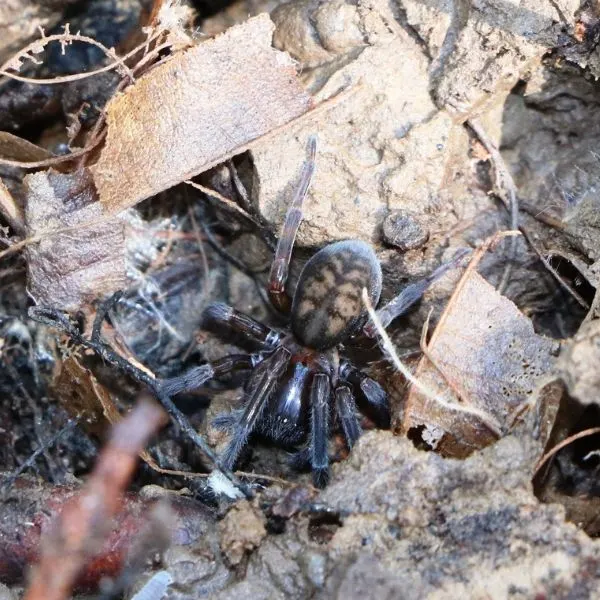
- Experience Level: Beginner
- Family: Amaurobiidae
- Scientific Name: Amaurobius ferox
- Other Names: Cribellate Spider
- Adult Size: 0.5 inches
- Lifespan: 1 to 2 years
- Average Price Range: N/A
The black lace weaver is an arachnid with a dark brown cephalothorax and gray or black abdomen. This abdomen often has light chevron-like markings in the middle, while the second half of this species’ dark brown legs are covered in gray hair.
Like many spiders in West Virginia, the black lace-weaver is a web-builder. It spins a wide, funnel-like web with a tube-like part that extends into its retreat. This retreat is often a crevice in the wall, under logs, or in some other dark, undisturbed place.
This spider is called a lace-weaver because the texture of its web is like a mesh or lace, especially when newly built. This web has a bluish hue and is not sticky, but its lace-like texture makes it easy for the legs of prey that wander into it to get caught in the mesh.
Black lace-weavers are nocturnal arachnids, so nighttime is when they typically sit on their webs to feed on prey. However, these spiders also often come out during the day to attend to prey caught in their webs.
These arachnids are not aggressive spiders, but they might bite if you threaten and prevent them from escaping. Fortunately, the venom they produce isn’t medically significant to humans.
14. Eastern Parson Spider
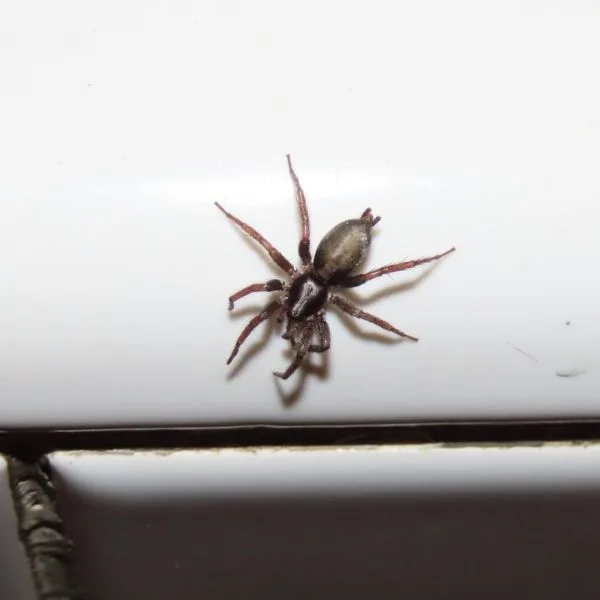
- Experience Level: Beginner
- Family: Gnaphosidae
- Scientific Name: Herpyllus ecclesiasticus
- Other Names: Stealthy Ground Spider, Ground Spider
- Adult Size: 0.3 to 0.8 inch
- Lifespan: 1 to 2 years
- Average Price Range: N/A
The eastern parson spider has a whitish pattern running down the center of its carapace and abdomen. This hairy black or gray arachnid gets its name from the resemblance of this whitish pattern to the neckband Catholic clergymen (or parsons) wore in the past.
Eastern parson spiders are swift spiders with a haphazard or zig-zag way of running. This zig-zag running pattern helps them escape predators, but it also makes them effective hunters.
This species belongs to a family of stealthy ground spiders that stalk their victims before attacking instead of building web traps. Once within reach, these spiders rush up to their targets and inject them with venom.
These arachnids don’t attack people unprovoked, but they can get aggressive when threatened. They won’t hesitate to inflict a painful bite if you back them into a corner, but the venom they inject doesn’t cause any medically significant symptoms.
You’ll find eastern parson spiders outdoors and indoors. Indoors, these spiders tend to hide in crevices and other dark, secluded areas around the home. These spiders are nocturnal, so you might not notice them except you’re up at night.
15. Arabesque Orbweaver

- Experience Level: Beginner
- Family: Araneidae
- Scientific Name: Neoscona arabesca
- Other Names: Spotted Orb-weaver
- Adult Size: 0.20 to 0.28 inch
- Lifespan: 1 Year
- Average Price Range: N/A
The arabesque orb-weaver comes in various colors, from brown to orange, yellow, or rusty brown. This spider gets its name from the resemblance of its abdominal pattern to the swirling designs seen on the walls and tiles of traditional Arab or Moorish buildings.
You’ll find arabesque orb-weavers among vegetation, where they spin large orb webs anchored to nearby branches and structures. These spiders tend to build their webs in fairly hidden places to avoid predators, but sometimes they build webs in open spaces.
When active, arabesque orb-weavers sit upside-down in the center of their webs and wait for insects to crash into the strands. These critters can detect when insects hit their webs because of the vibrations this impact triggers along the web strands.
Arabesque orb-weavers rush toward their victims and immobilize them with venom before consuming or stashing them away for later. These spiders are most active at night, while they spend most of the day resting in nearby retreats.
Like many orb-weavers in West Virginia, arabesque orb-weavers are harmless spiders. These spiders run when threatened and rarely bite people unprovoked.
Their venom is also not medically significant, so you’ll be fine even if one bites you.
16. Goldenrod Crab Spider
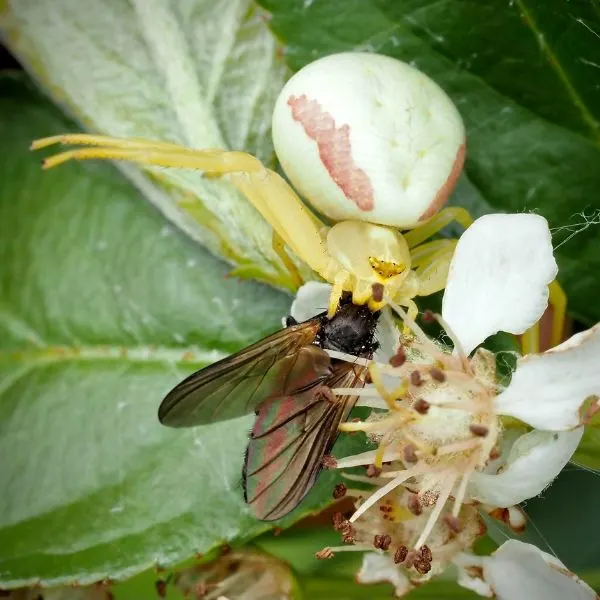
- Experience Level: Beginner
- Family: Thomisidae
- Scientific Name: Misumena vatia
- Other Names: Smooth Flower Crab Spider, Red-spotted Crab Spider, Flower Spider, Flower Crab Spider
- Adult Size: 0.12 to 0.75 inch
- Lifespan: 1 year
- Average Price Range: N/A
The goldenrod crab spider, or flower crab spider, is so named because it typically lives in flowerheads. This species is partial to goldenrod plants, from where it ambushes insects that come to pollinate the flowers and other arthropods that wander too close.
This arachnid doesn’t spin webs to catch its victims, relying instead on its stealth, speed, and strong limbs. Insects that come to pollinate flowers harboring this spider often don’t see it because the spider’s body blends in with the background.
Unlike most spiders in West Virginia, the goldenrod crab spider possesses the ability to change its color to match its surroundings. This color change is often only between yellow and white, and it can take weeks to complete, but the benefits are incredible.
Besides taking advantage of the camouflage its color-switching ability provides, this arachnid has two pairs of strong front legs that it uses to seize prey when hunting. These two leg pairs are larger than the spider’s remaining legs and resemble crab pincers.
Like crabs, this spider also has a flattened body, and it can walk forward, backward, and sideways without turning. These crab-like qualities are why this arachnid is called a crab spider.
Goldenrod crab spiders aren’t dangerous arachnids, and they don’t bite people unless threatened. The venom they produce is only potent against insects and other small prey, not humans.
17. Tiger Wolf Spider

- Experience Level: Beginner
- Family: Lycosidae
- Scientific Name: Tigrosa aspersa
- Other Names: Woodland Giant Wolf Spider, Speckled Wolf Spider
- Adult Size: 0.63 to 0.98 inches
- Lifespan: 1 to 2 years
- Average Price Range: N/A
The tiger wolf spider is a dark brown or black arachnid with hairy light brown patches on its body.
These light brown patches also form bands on the spider’s legs. In addition, the spider has a thin light brown line on its carapace that runs between its eyes.
You’ll find tiger wolf spiders outdoors, especially in woodlands and forests. These arachnids don’t spin webs for shelter or to catch prey. Instead, they hunt down their targets and subdue them with venom before eating.
The venom that these spiders produce is not harmful to humans, only to insects and other small prey. The spiders also rarely bite people, unless threatened and unable to escape on time. If you provoke this spider into biting you, expect some pain in the bite area.
Even though tiger wolf spiders don’t spin conventional webs, these arachnids use silk to create egg sacs. Females carry these egg sacs with them everywhere, until their eggs hatch into spiderlings.
After hatching, spiderlings live on their mothers’ backs for a while before dispersing. They feed on yolk while still on their mothers’ backs and only disperse when this yolk finishes and the young spiders start eyeing each other as prey.
18. Orchard Orbweaver

- Experience Level: Beginner
- Family: Tetragnathidae
- Scientific Name: Leucauge venusta
- Other Names: Long-jawed Orb-weaver, Venusta Orchard Spider, Orchard Orb-weaver
- Adult Size: 0.14 to 0.3 inch
- Lifespan: 1 year
- Average Price Range: N/A
The orchard orb-weaver belongs to a family of orb-weavers with long jaws and slender bodies. This species has a yellowish-green carapace with a dark line running down the center and sides, while its long abdomen has several colors.
This spider’s abdomen has a noticeable downward slant at the rear. The top part of this abdomen is usually silvery or white with black and yellow stripes, while the underside and rear bear a mix of yellow, orange, black, green, and white.
Although orchard orb-weavers build orb-shaped webs like other orb-weaving spiders in West Virginia, this species’ webs are horizontal, not vertical. The spiders sit upside-down in the hub of their webs and wait for prey to stick to the strands.
You’ll typically find these webs in orchards, which is where the spiders get their name. But these arachnids are also common in other vegetation-rich areas. When insects get caught in their webs, the spiders rush to immobilize them with venom before eating.
Orchard orb-weavers are unaggressive spiders that don’t bite people unless threatened, and even these types of bites are rare. The venom these arachnids produce is weak, so there’s no need to worry even if one bites you.
19. Furrow Orbweaver
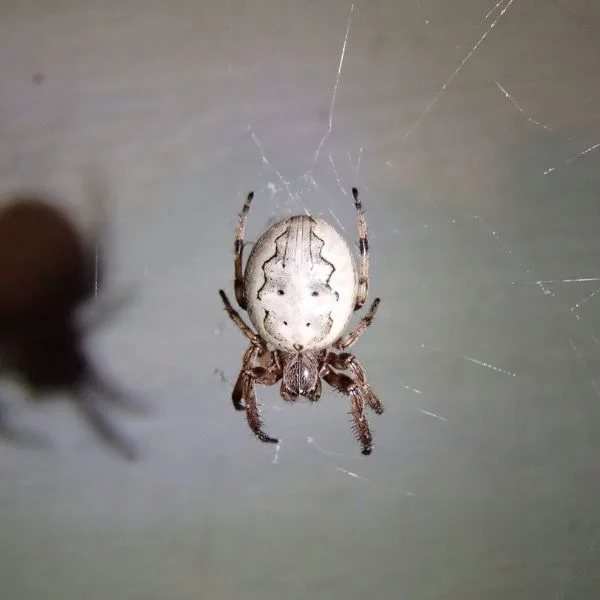
- Experience Level: Beginner
- Family: Araneidae
- Scientific Name: Larinioides cornutus
- Other Names: Furrow Orb Spider, Furrow Spider, Foliate Orb Spider, Foliate Orb-weaver
- Adult Size: 0.4 to 0.5 inch
- Lifespan: 1 Year
- Average Price Range: N/A
The furrow orb-weaver is a brown spider with spiny banded legs and a large abdomen. This abdomen has a broad black or dark brown pattern that resembles a serrated leaf when viewed in full, which is why the spider is also called a foliate spider.
The “furrow” in this spider’s name comes from the resemblance of this dark pattern’s wavy edges to the furrows formed after plowing the ground. These wavy edges give the spider’s abdomen the appearance of furrowed soil.
You’ll find furrow orb-weavers among vegetation, where they spin large wheel-like webs to catch prey. These spiders have poor eyesight, so they rely on vibratory signals from their web strands to know when the webs have caught prey.
These spiders rush toward their victims to inject them with venom. They may consume their victims immediately or wrap them in silk to preserve them for later.
Furrow orb-weavers, like most spiders in West Virginia, are harmless to humans. The spiders rarely bite people, and their venom is not medically significant.
20. Arrow-shaped Micrathena Spider

- Experience Level: Beginner
- Family: Araneidae
- Scientific Name: Micrathena sagittata
- Other Names: Triangulate Orb-weaver, Triangulate Orb Spider, Arrow-shaped Orbweaver
- Adult Size: 0.2 to 0.4 inches
- Lifespan: 1 year
- Average Price Range: N/A
The arrow-shaped micrathena spider is an orb-weaver with an unusual abdomen. Instead of being round or oval, the belly of this arachnid resembles a flying V guitar or an arrow nock. When viewed in full, the spider resembles an arrow, hence its name.
This spider has a black or reddish-brown cephalothorax with a yellow stripe on either side. Though its legs are also black or reddish-brown, the spider’s abdomen is yellow with dark spots. This abdomen has three pairs of pointed protrusions along the edges.
The first two pairs of these pointed protrusions are small, while the last pair is large. This last pair is at the rear, and it’s what gives the abdomen its arrow nock or V-shape. Unlike the rest of the abdomen, these protrusions are reddish brown with black tips.
You’ll find arrow-shaped micrathena spiders among vegetation, where they spin large orb webs to catch insects and other small arthropods. These arachnids rely on vibratory signals to detect prey caught in their webs before going over to immobilize their catch.
Like other orb-weavers in West Virginia, these spiders are unaggressive and harmless to humans. Females are also much larger than males and are the sex you’re most likely to encounter.
21. Western Lynx Spider

- Experience Level: Beginner
- Family: Oxyopidae
- Scientific Name: Oxyopes scalaris
- Other Names: Lynx Spider
- Adult Size: 0.16 to 0.3 inch
- Lifespan: 1 year
- Average Price Range: N/A
The western lynx spider is the striped lynx spider’s closest relative in the United States. This brown arachnid has several long spines on its legs and a broad light stripe running down the center of its carapace and abdomen.
Like its relative, this spider can jump. It also spins silk lines when jumping. The spider is common among vegetation in forests, farmlands, and gardens, where it feeds on various insects and arthropods that might otherwise act as pests.
Western lynx spiders are skilled predators that wait for prey to land close to them before stalking and attacking them. The “lynx” in these spiders’ names comes from their tendency to jump on their victims like lynx cats.
Western lynx spiders don’t spin webs to catch prey, but they use silk for other purposes. Besides spinning silk lines when jumping, females use silk to create protective sacs for their eggs. They then guard these sacs for as long as they can until spiderlings emerge.
Although these spiders might seem dangerous because of the spines covering their legs, western lynx spiders are harmless to humans. They won’t bite unless you threaten them, and the venom they produce is not medically significant.
22. Long-bodied Cellar Spider
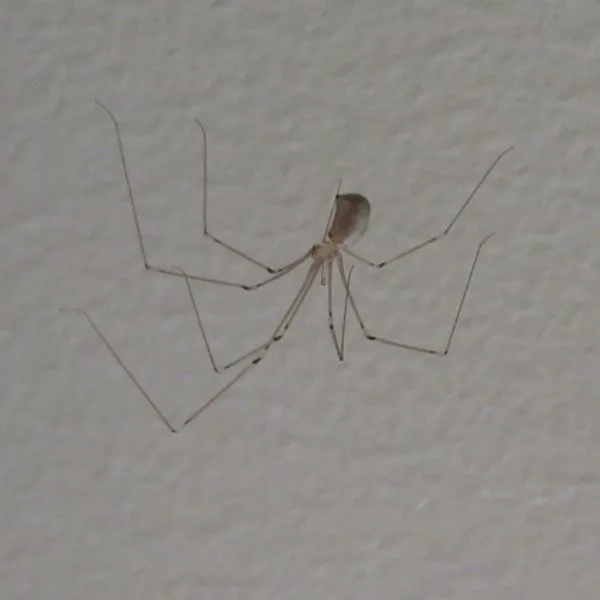
- Experience Level: Beginner
- Family: Pholcidae
- Scientific Name: Pholcus phalangioides
- Other Names: Daddy Longlegs, Elongated Cellar Spider, Cellar Spider, Daddy Longlegger, Carpenter Spider, House Spider, Granddaddy Longlegs, Vibrating Spider, Skull Spider
- Adult Size: Up to 0.4 inch
- Lifespan: 2 years
- Average Price Range: N/A
The long-bodied cellar spider is a small brown arachnid with an elongated abdomen. Its legs are incredibly long, sometimes up to six times its body length. The length of these legs is why the species is also called a daddy longlegs spider.
Long-bodied cellar spiders get their name from their tendency to build their webs in cellars. However, these spiders don’t restrict themselves to cellars. You’ll find their webs in ceiling corners, furniture joints, and other undisturbed parts of the house.
The webs long-bodied cellar spiders spin aren’t as neat as those of orb-weavers. These webs are tangled, haphazard silk masses, under which the spiders hang while waiting for prey.
These arachnids have poor eyesight and rely on the vibrations of their web strands to know when their webs have caught prey. When their webs catch prey, the spiders shake their webs vigorously to further entangle their catch before going in to immobilize it.
There are several stories about the potency of these arachnids’ venom. A common story is that their venom is among the deadliest in the world, only that these spiders’ fangs can’t penetrate human skin. This claim is false.
There’s still debate over whether or not the fangs of these spiders penetrate human skin. But what is clear is that the venom they produce is too weak to trigger any medically significant symptoms in humans.
23. Tan Jumping Spider
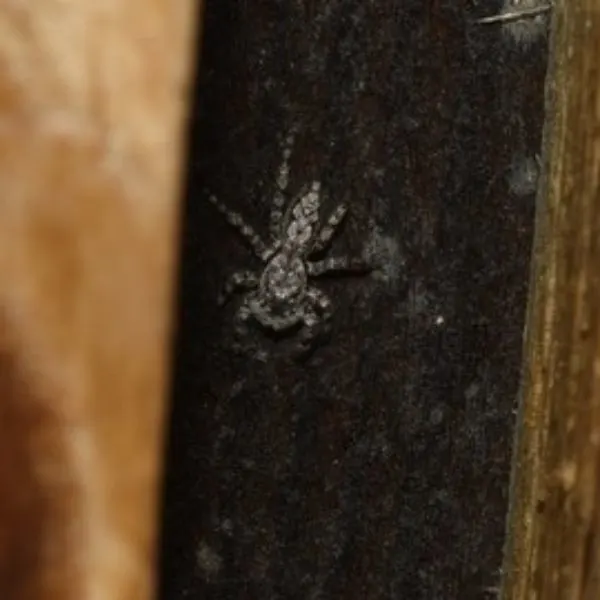
- Experience Level: Beginner
- Family: Salticidae
- Scientific Name: Platycryptus undatus
- Other Names: Bark Jumping Spider, Tan Jumper
- Adult Size: 0.33 to 0.51 inch
- Lifespan: 1 year
- Average Price Range: N/A
The tan jumping spider is a hairy tan, black, or gray arachnid with a white or light gray pattern running down its carapace and abdomen. This pattern resembles a narrow serrated leaf or a series of interlocked chevrons on the abdomen.
You’ll often find tan jumping spiders on vertical surfaces, such as on walls and poles around houses. You’ll also find many of these arachnids on tree bark in parks, fields, and woodlands.
Tan jumping spiders, like other jumping spiders in West Virginia, can leap several times their body length. They spin silk safety lines to aid with these jumps by providing balance and reduce the risk of injury in case their jumps go wrong.
These arachnids don’t build webs to catch prey, but they spin small silk shelters to rest in when inactive. When active, these spiders catch prey by ambushing and pouncing on their targets.
Tan jumping spiders also use silk to create egg sacs and build nests to host spiderlings after their eggs hatch. They guard their eggs and subsequent spiderlings for as long as they can until the spiderlings leave the nest.
24. Wetland Giant Wolf Spider

- Experience Level: Beginner
- Family: Lycosidae
- Scientific Name: Tigrosa helluo
- Other Names: Wetland Wolf Spider
- Adult Size: 0.39 to 0.67 inch
- Lifespan: 1 to 2 years
- Average Price Range: N/A
The wetland giant wolf spider isn’t the giant its name implies. In fact, it’s a pretty average-sized spider when compared with other species in its genus, such as the tiger wolf spider.
This species is a hairy dark brown arachnid with a yellowish-brown line running between its eyes and down the center of its carapace. The underside of its belly bears black spots that help tell it apart from most members of its family.
You’ll find wetland giant wolf spiders in various places, such as woodlands, fields, marshes, and other coastal areas. Most wolf spiders live in dry habitats, but this species is partial to wetlands, hence its name.
Like most wolf spiders, the wetland giant wolf spider is a solitary species that lives and hunts alone. You’ll rarely find this arachnid with company, except during mating seasons. It lives in silk-lined burrows and doesn’t spin conventional webs to catch prey.
Wetland giant wolf spiders prefer hunting down their prey. These predators either roam around in search of prey or wait in their foraging sites for prey to come around. Once within reach, these spiders ambush their victims and inject them with venom.
Wetland giant wolf spiders aren’t aggressive spiders, but they might bite if you provoke them. Fortunately, this bite doesn’t cause any medically significant symptoms. But the bite area might hurt a bit.
25. Bowl and Doily Spider

- Experience Level: Beginner
- Family: Linyphiidae
- Scientific Name: Frontinella pyramitela
- Other Names: Sheet-weaver
- Adult Size: 0.12 to 0.16 inch
- Lifespan: 1 year
- Average Price Range: N/A
The bowl and doily spider is a small brown arachnid with a shiny carapace and an abdomen bearing white vertical markings on the sides. These white markings resemble commas, and they turn yellowish as they curve under the spider’s belly.
This arachnid is a sheet weaver that gets its name from the structure of its web. This web is made up of two parts: a bowl-shaped web anchored to tree branches with tangled silk and a doily-like sheet web on which the bowl sits.
You’ll usually find this web near trees in forests and woodlands, where its large size and unique shape make it easy to spot. The doily or sheet web is typically anchored to the trunks of nearby trees or other structures.
Bowl and doily webs aren’t sticky, but their design makes them effective at trapping prey. Insects often accidentally fly into the tangled silk mass above the bowl, and the impact knocks them down into the bowl where this spider quickly immobilizes them.
You’ll typically find only one bowl and doily spider per web, but sometimes males share the same webs with females outside mating seasons. These spiders may compete for prey that falls into their webs.
Bowl and doily spiders are harmless to humans.
26. Common House Spider

- Experience Level: Beginner
- Family: Theridiidae
- Scientific Name: Parasteatoda tepidariorum
- Other Names: American House Spider, Common Cellar Spider
- Adult Size: 0.15 to 0.24 inch
- Lifespan: 1 year
- Average Price Range: N/A
The common house spider is a cobweb spider with a brown, yellow, or grayish-brown body and an abdomen stippled with dark markings. As its name suggests, this species is one of the most common indoor spiders in North America.
You’ll find this arachnid in various places indoors, from basements to attics, ceiling corners, and furniture bends. This spider spins its webs in random spots around the house, abandoning old webs for new ones if they don’t catch prey.
Like other cobweb spiders, this species spins tangled, sticky cobwebs to catch prey. It has poor eyesight, so it uses the vibration of its web strands to know when its web has caught prey. It then rushes over to immobilize its victim with venom.
The venom of this spider can be lethal to small arthropods, but it is harmless to humans. You might experience pain and mild swelling or redness if this spider bites you, but its venom is not medically significant. Fortunately, bites are rare.
27. Emerald Jumping Spider

- Experience Level: Beginner
- Family: Salticidae
- Scientific Name: Paraphidippus aurantius
- Other Names: Golden Jumping Spider, Emerald Jumper
- Adult Size: 0.28 to 0.47 inch
- Lifespan: 1 year
- Average Price Range: N/A
The emerald jumping spider is a stunning arachnid with an emerald green carapace and abdomen. Its cephalothorax has a brown or golden-brown stripe on each side and orange stripe curves around the top of its abdomen. Males are black with white stripes.
Like other members of its family, this arachnid can jump several times its body length. It anchors a silk safety line to the surface from which it’s jumping so it can control the extent of each jump and reduce the risk of injury if something goes awry.
You’ll find the emerald jumping spider outdoors on walls and trees around human habitation or in woodlands and bushes. This arachnid doesn’t spin conventional webs for shelter or prey capture. Instead, this spider lives in small silk nests.
When hunting, this spider stalks its targets instead of building web traps. When within reach, it jumps on its victims and injects them with venom to subdue them. It may consume its victims on the spot or drag them to its shelter.
Like most spiders in West Virginia, the emerald green jumping spider is harmless to humans. It doesn’t bite people unless threatened, and its venom is not medically significant.
28. Spotted Orbweaver

- Experience Level: Beginner
- Family: Araneidae
- Scientific Name: Neoscona crucifera
- Other Names: Barn Spider, Hentz Orb-weaver
- Adult Size: Up to 0.75 inch
- Lifespan: 1 year
- Average Price Range: N/A
The spotted orb-weaver is a drab spider with a hairy carapace and spines on its legs and a large, oval abdomen. Females may be reddish-brown, while males are light brown. These colors may fade into gray or grayish-brown in adulthood.
Although juveniles have a colorful pattern on their backs, this pattern is indistinct in adults. This arachnid belongs to the same genus as the arabesque orb-weaver, and both species may be hard to tell apart without close examination.
You’ll find spotted orb-weavers among vegetation. These arachnids prefer moist forests and woodlands over drier ones, and they show a liking to habitats with plenty of hardwood. Like most orb-weavers, these arachnids spin large orb webs in their habitats.
Juveniles build their webs at night and take them down during the day, but adult females often leave their webs up. Since these spiders are nocturnal, they usually spend the day hiding in retreats made from leaves bound with silk.
When these spiders climb their webs at night to feed, they rely on vibratory signals from their web strands to know when the prey has hit their webs. They then rush to immobilize their victims with venom before eating.
Spotted orb-weavers, like other orb-weavers in West Virginia, are harmless to humans,
29. Woodlouse Hunter

- Experience Level: Beginner
- Family: Dysderidae
- Scientific Name: Dysdera crocata
- Other Names: Woodlouse Spider, Sowbug Hunter, Cell Spider, Slater Spider, Pillbug Hunter, Roly-Poly Hunter, Sowbug Killer, Long-Fanged Ground Spider, Orange Spider
- Adult Size: 0.35 to 0.59 inch
- Lifespan: 3 to 4 years
- Average Price Range: N/A
The woodlouse hunter is a reddish spider with long fangs and six eyes instead of the eight other spiders possess. These eyes are arranged in a circular pattern on the head and help differentiate this species from the broad-faced sac spider.
Woodlouse hunters get their name from their tendency to prey on woodlice and similar bugs. You’ll find these arachnids on the ground in forests and woodlands, where they often live close to woodlice populations.
These arachnids are skilled hunters that don’t use webs to trap their victims. When hunting, these critters stalk their victims and attack when they get close enough. They pierce their victims’ exoskeletons with their long fangs to inject venom.
Woodlouse hunters can seem dangerous, especially because of their noticeably long fangs. But these arachnids aren’t. They won’t bite you unless you threaten them. And even then, their venom doesn’t cause medically significant symptoms in humans.
30. Barn Funnel Weaver

- Experience Level: Beginner
- Family: Araneidae
- Scientific Name: Tegenaria domestica
- Other Names: Drain Spider, Barn Spider, Funnel Web Weaver
- Adult Size: 0.24 to 0.45 inch
- Lifespan: 1 to 7 years
- Average Price Range: N/A
The barn funnel weaver is a brown or grayish-brown spider with a thin black stripe at the edges of the carapace and a broad stripe on either side of the midline, Like most of its relatives, the abdomen is dark with light chevron markings and prominent spinnerets.
You’ll find the barn funnel weaver in various places, such as sheds and barns, hence its name. But this species is also common under floorboards, in wall crevices, and under rocks and other items outdoors.
This spider is related to both hobo and grass spiders. Like them, it spins a funnel-shaped web with a tube-like part that leads to its retreat. Unlike grass spiders, its web has a smaller diameter and the retreat is usually within the wide funnel sheet.
The web this spider builds isn’t sticky, but it works well in helping the spider capture prey. When arthropods climb into the outer parts of the funnel web, vibratory signals travel through the web strands to alert the spider.
This spider then rushes out to attack and subdue these arthropods with venom. It may consume its victims immediately or drag them back into its retreat to feast on them.
barn funnel weavers, like most spiders in West Virginia, don’t bite people unprovoked, Their venom is also harmless to humans.
Frequently Asked Questions
You probably still have questions about spiders in West Virginia. Read on to get answers to your most pressing questions.
What do spiders in West Virginia eat?
Spiders in West Virginia mainly feed on insects and other small arthropods. Many spiders feed on other spiders, including their species’ members. Female black widows, in particular, are well-known for consuming their partners after mating.
Besides arthropods, some spiders feed on small vertebrates and non-arthropod invertebrates that their venom can subdue. Some spiders also feed on plant matter, such as pollen and nectar in addition to animals.
Do spiders in West Virginia have good eyesight?
Some spiders in West Virginia have good eyesight, while others don’t. Hunting spiders like wolf spiders and jumping spiders tend to have excellent vision, which they use to scout prey. But you might also encounter some hunting spiders with weak vision.
On the other hand, most web-building spiders in West Virginia have poor eyesight. That’s why these critters rely on their webs to catch prey and make sense of their environments.
Where can I find spiders in West Virginia?
Spiders are everywhere in West Virginia, from your home to your office. Many spiders live indoors in crevices, basements, wall corners, and other secluded spaces. But even more spider species live outdoors.
If you’re looking for a particular spider species, it’s best you look up its natural range before going out to find it. Spiders live in various habitats, and while some are partial to moist vegetation-rich areas, others prefer arid places.
Are there any poisonous spiders in West Virginia?
Yes, there are venomous spiders in West Virginia. Virtually all spiders in the state are venomous. The good news is that the venom most of these spiders produce is harmless to humans. Only black widows produce medically significant venom in West Virginia.
Although you’ll often hear people refer to spiders as poisonous, that isn’t the right word. Spiders are venomous, not poisonous. Venomous means they inject venom when they bite, while poisonous means they are harmful when consumed.
Can a spider bite kill you?
Yes, a spider bite can kill you. But it is highly unlikely that a spider bite will. That’s because spiders rarely bite people. Even when forced to bite, the venom most spiders inject is too mild to harm people, let alone kill them.
In West Virginia, the southern black widow is the only species that produces venom potent enough to cause death. Thankfully, the spider doesn’t inject people with a venom dosage high enough to cause death. The spider also rarely bites people.
What is the deadliest spider in West Virginia?
The southern black widow is West Virginia’s deadliest spider only because its neurotoxic venom causes medically significant symptoms that might require urgent medical attention or lead to death in extreme cases.
But the spider is rarely ever truly deadly. This arachnid is timid and doesn’t bite people unprovoked. In addition, its venom doesn’t cause any long-term damage in the majority of people it bites.
Are there brown recluses in West Virginia?
No, there are no brown recluses in West Virginia. Most brown recluse sightings in this state are the result of misidentifying similar-looking spider species for brown recluses. True brown recluse sightings are isolated incidents and often happen indoors. These are typically brown recluses that have hitched a ride into West Virginia via cargo brought in from other states.
Are there jumping spiders in West Virginia?
Yes, there are jumping spiders in West Virginia. The state is home to several species, many of which some people keep as pets.
Are there black widows in West Virginia?
Yes, there are black widows in West Virginia. The southern black widow is the species you’re most likely to encounter in the state. It’s also one of the most well-known species because of its powerful venom.
Is it legal to own a pet spider in West Virginia?
Yes, you can legally own a pet spider in West Virginia. The state doesn’t include spiders on its list of prohibited species. However, laws can change. So you should check in regularly if you’re considering keeping pet spiders.
How many species of spiders are there in West Virginia?
There are over 30 different spider species in West Virginia, but most of them are poorly documented. The exact number is unclear because there is no comprehensive official record of all spiders in the state.
What are the most common spiders in West Virginia?
Orb-weavers and wolf spiders are among the most common outdoor spiders in West Virginia. Indoors, cobweb spiders and cellar spiders are among the most encountered species.
Conclusion
Although spiders get a bad rep for being creepy and dangerous, they usually aren’t. West Virginia has only one highly venomous spider, and even this spider rarely bites people except as a last resort when threatened.
You’ll find all sorts of spiders in West Virginia, from species that build large, annoying webs, to those that don’t. Spiders don’t all look the same or behave the same. While some species do indeed seem creepy, you’ll find several stunning spiders in the state.
Except your home is overrun by spiders or you’re harboring potentially dangerous species, there’s usually no need to get rid of these arachnids.
